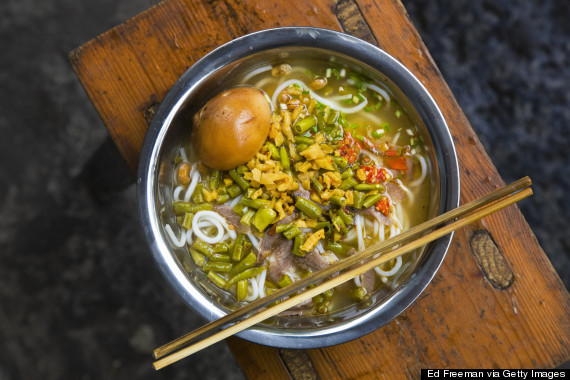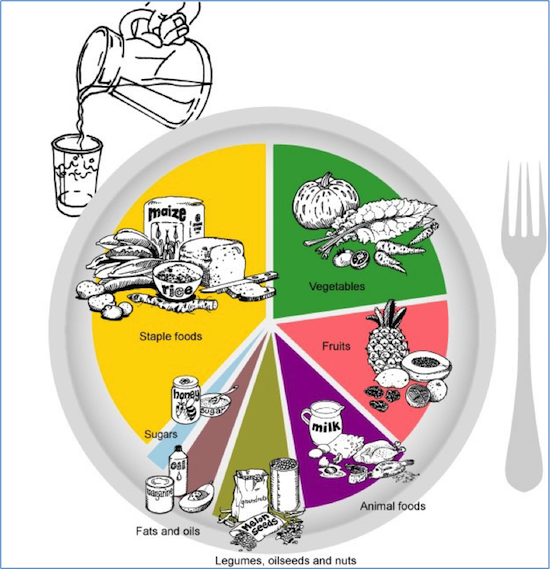Healthy Diets During the Lifecycle


A healthy diet is a requirement for good health. To promote healthy diets throughout the life cycle, context-specific and tailor-made recommendations are needed for different target groups. The Daily Recommended Intakes for Energy and Nutrients as presented in a previous food-pedia page can be used as a starting point for public policies and nutrition education programs. However these recommendations need to be translated into practical information using language and symbols that the public can easily understand. The information should focus on foods (groups) that are commonly consumed, on portion sizes, as well as on related behavior and care.
The Family Nutrition Guide, developed by FAO, includes a practical fact sheet on a healthy diet, providing basic recommendations for healthy adults. In addition fact sheets for specific target groups, such as pregnant and breastfeeding women, babies, infants and children have been developed, addressing their dietary needs.
Below the principle recommendations are summarized, followed by the links for the different fact sheets.
A healthy diet is important because it:
- keeps the body and mind healthy
- gives the body energy to be active and function well
- helps the body to grow and repair itself
- helps the body to fight infections and illness
- makes children grow well
- makes pregnant women produce healthy babies.
A healthy diet has a variety of foods from different food groups
| Staple foods | Cereals: e.g. maize/cornmeal, millet, sorghum, wheat flour, rice Starchy roots: e.g. potato, sweet potato, yam, fresh cassava, cassava flour, plantain |
| Legumes, oilseeds and nuts | Legumes: e.g. cowpea, pigeon pea, kidney bean, lentil, chickpea, groundnut Oilseeds: e.g. soybean, pumpkin, sunflower seed, sesame, melon seed |
| Vegetables and fruits | Vegetables: e.g. tomato, pumpkin, carrot, spinach and other leaves, orange, sweet potato, sweet pepper, eggplant Fruits: e.g. mango, pawpaw, passion fruit, orange, pineapple, banana, dates |
| Animal foods | Meat, offal, poultry and fish: e.g. beef, goat, sheep, pork, liver and other offal, chicken, fresh or dried or canned fish Milk, eggs and dairy products: e.g. fresh cow milk, fresh goat milk, eggs, curds, yoghurt, cheese |
| Fats and oils | Fats: e.g. butter, margarine, fat from meat, ghee Oils: e.g. coconut oil, sunflower oil, groundnut oil, red palm oil, maize oil, oilseeds |
A healthy, balanced diet has the right proportions of good quality foods. The plate below shows the proportions of the different food groups. In addition it is recommended to have a total of at least 2-3 meals per day and to drink plenty of water (e.g. 8 cups a day).

Please note that Sugars (e.g. sugar cane, honey, jam) are included in the Food Plate as they can play a role in meeting the overall energy needs. However it is not necessarily part of a Healthy Diet.
To increase adequate use of important nutrients it is recommended to:
- Eat fruits with every meal to improve iron absorption
- Add a little fat (oil or butter) to increase absorption of vitamins
- Use iodized salt to get enough iodine, while not using more than 1 teaspoon per person per day.
For more detailed information for specific target groups please refer to the following fact sheets:
- A healthy diet
- Food for pregnant and breastfeeding women
- Feeding babies aged 0-6 months
- Feeding young children aged over 6 months
- Feeding school-age children and youth
Another source with more detailed nutrition information is the WHO e-Library of Evidence for Nutrition Actions (eLENA)1. This is an online library of evidence-informed guidance for nutrition interventions. It is a single point of reference for the latest nutrition guidelines, recommendations and related information including supporting materials such as scientific evidence, background materials and commentaries from invited experts.

